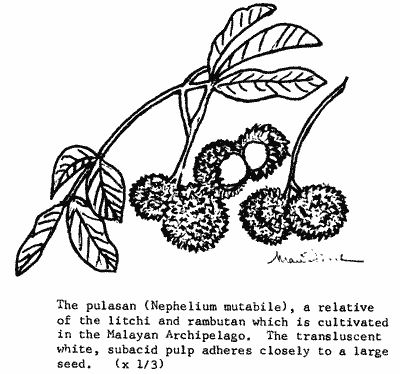
PULASAN
SCIENTIFIC NAME: Nephelium mutabile
FAMILY: Sapindaceae
This tree is a native to Borneo and neighbouring areas, and is related to the litchi, rambutan, longan and alpay. Other common names are kapoelasan, capulassan and pulassan, whilst in the Philippines its common name is Bulala.
Native bulala can be found in the Philippine mountains, but the fruit is poor. It is, however, used by most propagators as root stock for pulasan because of its strong growth. The introduced pulasan is of a very fine quality, and many who have tasted the fruit consider it superior to that of the Chinese litchi.
The pulasan is a tree that will adapt from sea level to some 300 metres. In fact, in Jakarta, they are raised between 230 and 300 metres above Sea level. It prefers a well-distributed rainfall and is more resistant to drought than the rambutan.
The first imports to the Philippines were from Indonesia in 1912 and were grown from seed. However, the more successful pulasan was introduced as a budded plant, but its variety is not known. The fruit are of very fine quality, and it is suspected that it is of the sibabat variety. Some of the commercial varieties in Indonesia are koeneng, merah, poetih and sibabat.

The fruit is larger than that of the rambutan with a stouter stem. Fruit are in closely-crowded clusters of three to five fruit, with a thick pericarp or outer covering which is twisted off before eating the fruit. The skin can be up to 3/8" thick, whilst the spines are short compared with the rambutan, whose skin is rarely more than ¼" thick and whose spines are much longer and taper uniformly towards the base. The flesh is less juicy than that of the rambutan. It is translucent, white, and one variety is said to be seedless. The normal seed is much the same size as that of the rambutan.
Pulasan should be propagated asexually by budding, inarching, cleft grafting or marcotting. For the beginner, inarching and marcotting are recommended. In the Philippines, pulasan seed is not common, most propagators using that of the bulala. If available, pulasan seedlings should be used as stock. Rambutan cannot be used. Some male trees should be planted among the purely female trees as a source of pollen.
The trees are normally planted in the field at 8 to 10 metres apart, or, if planted in the back yard, this distance can be reduced. An asexually propagated pulasan begins to fruit in three to four years from planting, whilst the seedling tree takes about seven years.
Pests and diseases have not been a major problem in either the pulasan or the rambutan in any country.
DATE: May 1981
* * * * * * * * * * * * *
